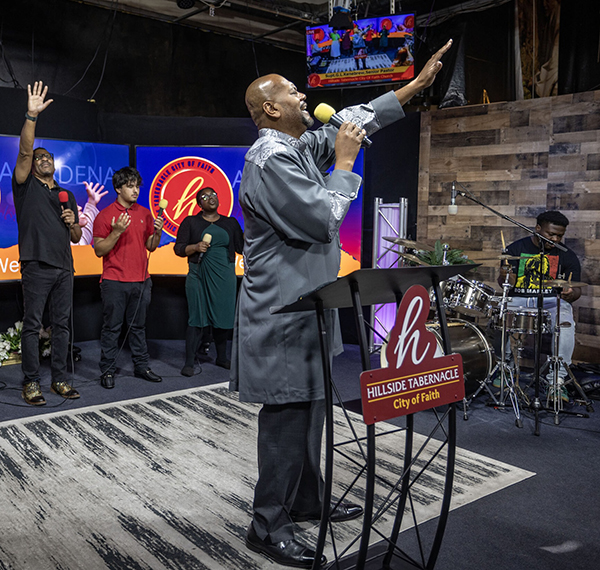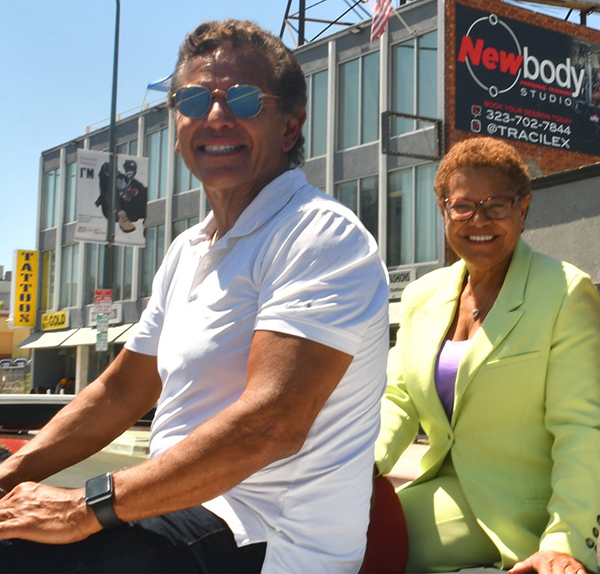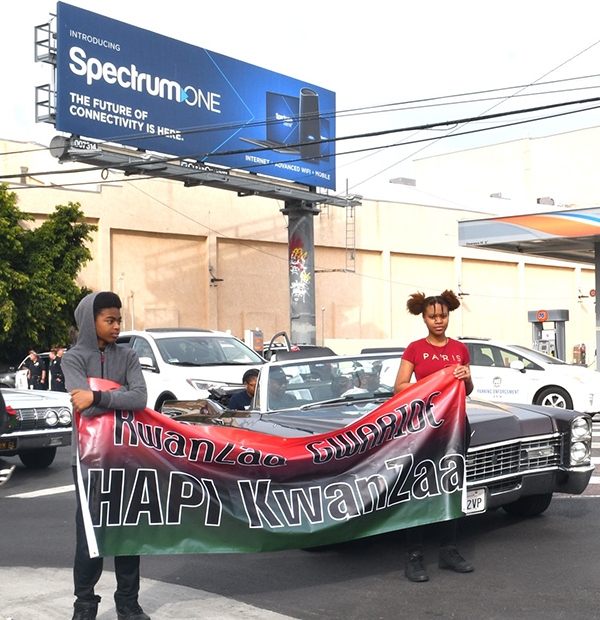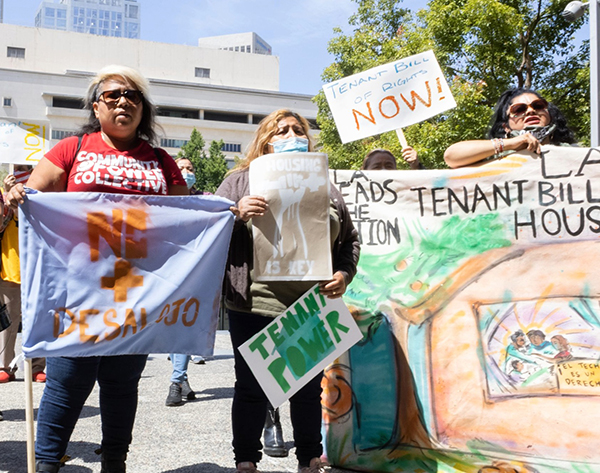Altadena pastors keep church community going after fire

Pastor LaKeith Kenebrew delivers a sermon to congregants of the Hillside Tabernacle Church at a rented studio in Duarte in July. His Altadena church was destroyed by the January wildfire.
Photo by Barbara Davidson
By Jessica Goodheart
Contributing Writer
ALTADENA — For the past six months, Pastors LaKeith and Jerice Kenebrew have been reporting to work at Hillside Tabernacle Church, one of 11 houses of worship damaged or destroyed in the Eaton fire last January.
On any given day, the Kenebrews juggle visits to the church from workers and contractors while navigating the long process of rebuilding their home, one of more than 9,000 structures destroyed in the fire.
The Kenebrews’ ability to minister to their congregation is now limited. Before the fire, the couple held community events and multiple services a week at the church. Now, only Sunday services remain — and those are livestreamed from a rented studio tucked in an industrial park in Duarte, a city located about 12 miles east of their damaged church. Congregants who are fire survivors are now scattered throughout the county.
From offices inside a church that lacks power and an internet connection, Jerice Kenebrew calls members of the congregation individually and posts encouraging affirmations on the church’s Facebook page.
“I let them know that we’re here. They can call any time,” she said.
But on Sunday afternoons in their rented studio, their week takes a joyful turn as congregants clap, sway and pray through a service, enlivened by a percussionist, two synthesizers and Jerice Kenebrew’s powerful singing voice. Near the end of a recent service, LaKeith Kenebrew, dressed in a white tunic, pointed congregants to legal and recovery resources — then returned to a message of resilience.
“We have been devastated,” he said, “but God has given grace to us.”
The Kenebrews are fighting to keep a community of more than 150 congregants together after the January wildfires, which destroyed the home they shared with their 24-year-old son and displaced Jerice Kenebrew’s parents, who also lost their home in the fire.
This family’s story of loss is repeated across the region, with tens of thousands of homes destroyed in the Eaton fire and the Palisades fire, which erupted along the coast on the same day. For Black families like the Kenebrews, the disaster also threatens a deep-rooted presence in Altadena and raises questions about the future of a historically Black community in Southern California.
Frances Harris, Jerice Kenebrew’s 76-year-old mother, is an elegant woman with a quiet, dignified presence. It is through her parents that the idea for this church was born. Hillside Tabernacle initially opened in a storefront just up the street in 1967.
In the late 1980s, the church moved into its current building — a former post office on Fair Oaks Boulevard, sold off by private owners as Black families moved in and white residents left. Frances Harris remembers the sellers calling the area “ghetto.”
In 1999, Frances and her husband Jerry Harris took over leadership of the church. Like his wife, Jerry Harris had deep roots in the community. He attended Pasadena public schools, including John Muir High School, baseball legend Jackie Robinson’s alma mater.
Jerry Harris would later become the Pasadena Department of Water and Power’s first Black cable splicer, a job that involves installing high voltage electrical cables underground. Their four-bedroom house became a gathering place for the family.
Despite all they had built, the Harrises had no insurance when their home burned in January. They blame their mortgage servicer for failing to pay their premium after being forced onto the California FAIR Plan, the state’s so-called insurer of last resort.
Their original insurer had dropped them months earlier due to fire risk. The Harrises are suing their mortgage servicer, as well as Southern California Edison, whose equipment may have sparked the blaze.
In early July, six months after the fire, 70% of survivors reported their claims had been delayed, denied or underpaid. For the Harrises, navigating the Federal Emergency Management Agency was an ordeal.
“We went to the office at least 20 or 30 times,” Frances said. “I got sciatica from the stress.”
And the family is still coping with the trauma caused by the fire itself. Like about a dozen members of the congregation, Jerry Harris is a veteran.
“Just driving through the area will trigger him because it looks like a war zone,” LaKeith Kenebrew said of his father-in-law, who saw combat in Vietnam.
Jerice Kenebrew remembers the night of Jan. 7 vividly.
“Everything was just red and orange,” she said.
She and her husband spent the night driving back and forth into the fire zone in spite of the hurricane force winds, as they tried to save their church. It wasn’t until a week later that she began to question their actions.
“I said, what were we thinking, putting our lives at risk so many times?” Jerice Kenebrew remembered.
Their persistence — they visited the church seven times over the course of the night — helped save the structure.
“I think the last time we came, the roof was on fire,” Jerice Kenebrew said. “We saw smoke coming out, and we tried to flag down three different fire trucks. Finally, we just jumped in the middle of the street in front of a fire truck and made them stop.”
Jerice Kenebrew stood outside her damaged church where signs of destruction surrounded her: the charred remains of the community center once connected to the church, empty lots recently cleared by the Army Corps of Engineers, a liquor store and grocery down the street reduced to rubble. Across the way, a row of duplexes that had housed church members stood as a scorched shell. Some days, she said, she can’t stop crying.
Their son David was safely away from the fire, but still endured a harrowing night. Around 3:30 a.m., his Alexa app began pinging — alerting him to breaking glass as flames consumed the family’s home, less than a mile from the church. From the safety of a friend’s house, he tried frantically to reach his parents, but fire-damaged cell towers made contact impossible.
“I think the initial impact really scared him,” Jerice Kenebrew said. “He realized he could have lost his parents that night.”
The Kenebrews’ house and their church are both west of North Lake Avenue in Altadena — a historic redlining boundary that decades ago barred Black residents from buying homes east of the line. The line also gained tragic significance during the fire.
While thousands of those living east of the line received evacuation notifications before midnight, Altadena residents living west of the North Lake Avenue did not receive those warnings until 3:25 a.m., four hours after the first reports of fires in the area.
About seven months after the disaster, the reasons behind the failure of Los Angeles County’s electronic alert system remain unclear. In May, county Supervisor Kathryn Barger told the Los Angeles Times hat it stemmed from a “breakdown in the communication” among county fire, sheriff and emergency management officials — agencies that were jointly responsible for issuing evacuation alerts.
But more recently, the supervisor’s views have evolved, according to Helen Chavez Garcia, her spokesperson. As Barger heard firsthand accounts from members of the command post, she grew less certain that officials could have accurately anticipated the fire’s path.
“The ambient weather conditions were just awful,” Chavez Garcia said, adding that the conditions made it difficult to gauge “the directionality of those embers.” She said fuller answers are expected in a quarterly report by an outside consultant that is to be published in late October.
LaKeith Kenebrew radiates warmth both from the pulpit and in the quieter surroundings of his office. But his voice takes on a detectable edge when he describes what he sees as disparate treatment of the heavily Black and Latino parts of Altadena and the more affluent and more heavily white neighborhoods to the East, both during the fire and in its aftermath.
“We received a warning to get out [at the time] that my son’s Alexa was saying windows are breaking at your house, which literally means that my house was burning down at the time they were telling us” that the fire was approaching, he said.
Large swaths of West Altadena burned in the Eaton fire, and all but one of the 19 deaths associated with the fire occurred in the heavily Black and Latino neighborhoods west of Lake — which was also the last to burn in the regionwide firestorm.
A Los Angeles Times investigation found that the Los Angeles County Fire Department had just one county fire truck in West Altadena at 3:08 a.m. on Jan. 8. The county’s fire chief, Anthony C. Marrone, defended his department’s response in a video shown at a virtual community meeting in late July, saying that the article relied on data that presented an incomplete picture of the number of fire trucks in the area at the time.
In April, sitting in his office, LaKeith Kenebrew praised elected officials — from the state’s governor to congressional leaders to Barger — who he said are helping the community and the church get the support they need. But in early June, he also said he sees an imbalance in how the rebuilding is playing out.
“There’s just a difference,” he said. “Who gets taken care of first? Who has the opportunity to have removal services? Who is still in hotel rooms and fighting to get FEMA and SBA [Small Business Administration] loans, you know, versus those who are already through the process?”
Among the displaced is Robert Sanders, a 72-year-old retiree. In July, he arrived at the rented Duarte studio in a gray pinstripe suit — church ready, despite having spent the night in his 2009 Infiniti.
Six months after the fire, his savings were gone. He was splitting nights between a hotel room in Ontario and his car. FEMA paid for four months of hotel stays before that money ran out, Sanders said.
LaKeith Kenebrew helped connect him to a donor who gave him $5,000 — money that vanished quickly after he started paying for his own hotel room.
LaKeith Kenebrew’s sermon that day had ended in a fiery invocation, which he delivered as he stepped away from the podium and moved among those assembled. He urged the congregation to push back against “brokenness of heart, brokenness of spirit, financial oppression — all of those things fighting against you,” with the help of a God he called upon to “destroy every yoke.”
Asked what had inspired him most that day, Sanders replied, “Most everything the pastor said lifted me up,” adding, “The church is my life.”
This article was produced by Capital & Main, a nonprofit publication focused on inequality. It is republished here with permission.





